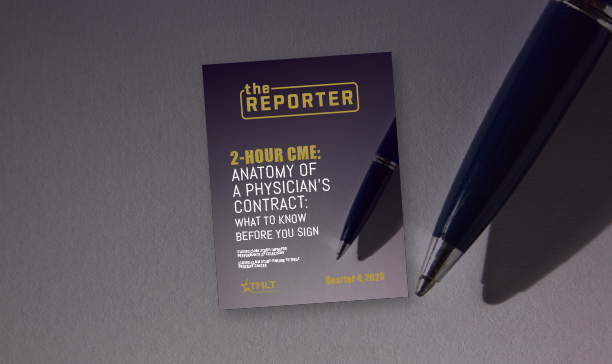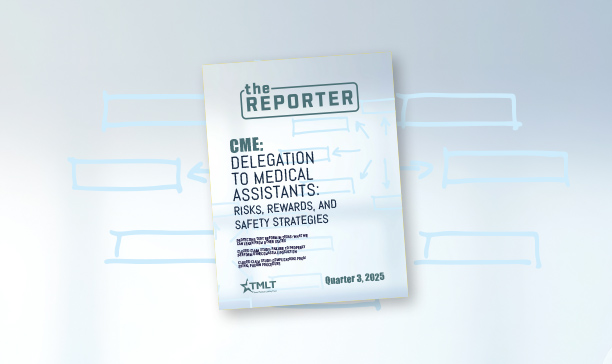Failure to timely evaluate patient
A 25-year-old man came to the emergency department with left upper quadrant abdominal pain.Imaging studies and lab results were unremarkable.
Presentation
A 25-year-old man came to the emergency department (ED) on a Thursday with left upper quadrant abdominal pain. He was evaluated by EM Physician A.
Imaging studies and lab results were unremarkable. The patient was given a “GI cocktail” and pain medications that improved his symptoms. The final diagnosis was “acute abdominal pain, rule out peptic ulcer disease versus gastritis.” EM Physician A documented: “He is to follow up with the gastroenterologist tomorrow or Monday and return immediately for any change or worsening.” The patient was referred to a gastroenterologist and discharged.
The patient returned to the ED on Saturday, two days after his initial visit, with continued abdominal pain. He was seen by EM Physician B whose examination revealed diffuse abdominal tenderness. Lab studies were unremarkable. An abdominal CT with contrast was interpreted as non-specific, suggesting the possibility of a mild ileus, “but certainly no obstructive effect is seen.” The differential diagnosis included inflammatory bowel disease, enteritis, early appendicitis, and early bowel obstruction.
EM Physician B documented that he did not feel the patient had a surgical abdomen, and noted he had an appointment with a gastroenterologist on Thursday. The patient was discharged with instructions to return if he experienced increased pain, fever, vomiting, or blood in the stool.
When the patient returned to the ED on Sunday, EM Physician B obtained a surgical consult. The surgeon did not believe the patient had a surgical abdomen and recommended referral to a gastroenterologist. The EM Physician B called a gastroenterologist who agreed to admit the patient.
Physician action
The gastroenterologist saw the patient at 5 p.m. She requested a surgical consult and ordered repeat scans of the abdomen and pelvis. She requested the scans “tonight” and that she be contacted by telephone with the results. The coding sheet for the imaging studies indicated the order was received “stat” at 5:05 p.m.
That evening, the patient developed fever and tachycardia. The gastroenterologist was contacted, and she ordered blood culture testing and antibiotics. She again instructed “call tonight for problems and results of abdominal CT.”
The patient was not taken to radiology until approximately 11:30 p.m., and returned to the room at 1:30 a.m. The records reflect that nursing staff called the gastroenterologist two more times overnight, but she was not told of the results of the CT scan. The gastroenterologist did authorize the patient to receive clear liquids by mouth.
Documentation received during the investigation of this claim suggested that the radiology tech who obtained the CT scan called a clerk at the radiology group to advise that he would be sending over images by teleradiology for a stat interpretation. The tech did not speak directly with the on-call radiologist.
At 6:15 a.m., a general surgeon saw the patient. He reviewed the original CT films and diagnosed a small bowel obstruction. He took the patient to surgery for an urgent laparotomy. Of note, the formal radiology report with the results of the abdominal CT were called in to the gastroenterologist at 6:10 p.m. that evening.
Anesthesia induction began at approximately 7:50 a.m. During induction, the patient aspirated a large amount of stomach/bowel contents. During the procedure, the surgeon evacuated approximately 3 liters of feculent matter from the patient’s stomach and small bowel through an NG tube.
The surgeon then located a bowel obstruction at the distal terminal ileum. He felt that the obstruction was caused by a congenital fibrous band of tissue across the bowel. The non-viable segment of bowel was resected and the bowel closed with an end-to-end anastomosis. The surgery was completed and the patient was transferred to the ICU.
The patient remained intubated after surgery. In the following days he developed acute respiratory distress syndrome and aspiration pneumonitis. His condition deteriorated to multi-organ failure. He suffered a cardiac arrest and died nine days after the surgery.
Allegations
A lawsuit was filed against the hospital, EM Physician B, the radiology group, the gastroenterologist, the anesthesiologist, and the general surgeon. The allegations were:
- failure to admit the patient after his second visit to the ED (EM Physician B);
- failure to timely obtain surgical consultation; (gastroenterologist)
- failure to timely follow-up on the results of the stat CT scan (gastroenterologist);
- failure to timely interpret and report the results of the stat CT scan (radiology group);
- failure to timely evaluate the patient (general surgeon);
- failure to order NG tube drainage before surgery (general surgeon);
- failure to assure proper anesthesia procedures during surgery (general surgeon); and
- failure to take appropriate measures to prevent regurgitation during induction of anesthesia (anesthesiologist).
Legal implications
Three consultants reviewing this case for the defense were critical of the care provided by the general surgeon and the gastroenterologist. Specifically, these defendants should have ordered placement of an NG tube when the diagnosis of small bowel obstruction was made. The consultants also voiced criticism of the anesthesiologist for failing to protect against aspiration by performing rapid sequence induction with cricoid pressure.
The plaintiffs were able to obtain expert support for their theories of liability. At deposition, the plaintiff’s experts stated that if it had not been for the aspiration event, the patient would have survived the surgery without complication.
It was further claimed that the failure to order an NG tube was a proximate cause of the aspiration event. These allegations were directed toward the general surgeon and the anesthesiologist. The plaintiffs did not assert that earlier diagnosis and surgery would have prevented the aspiration. This lack of testimony regarding proximate cause weakened the case against EM Physician B, the radiology group, and the gastroenterologist.
Disposition
This case was settled on behalf of the general surgeon, the anesthesiologist, and the hospital. The case against EM Physician B, the radiology group, and the gastroenterologist was dropped.
More on improper performance
Risk management considerations for general surgeons
Disclaimer
Presentation
A 25-year-old man came to the emergency department (ED) on a Thursday with left upper quadrant abdominal pain. He was evaluated by EM Physician A.
Imaging studies and lab results were unremarkable. The patient was given a “GI cocktail” and pain medications that improved his symptoms. The final diagnosis was “acute abdominal pain, rule out peptic ulcer disease versus gastritis.” EM Physician A documented: “He is to follow up with the gastroenterologist tomorrow or Monday and return immediately for any change or worsening.” The patient was referred to a gastroenterologist and discharged.
The patient returned to the ED on Saturday, two days after his initial visit, with continued abdominal pain. He was seen by EM Physician B whose examination revealed diffuse abdominal tenderness. Lab studies were unremarkable. An abdominal CT with contrast was interpreted as non-specific, suggesting the possibility of a mild ileus, “but certainly no obstructive effect is seen.” The differential diagnosis included inflammatory bowel disease, enteritis, early appendicitis, and early bowel obstruction.
EM Physician B documented that he did not feel the patient had a surgical abdomen, and noted he had an appointment with a gastroenterologist on Thursday. The patient was discharged with instructions to return if he experienced increased pain, fever, vomiting, or blood in the stool.
When the patient returned to the ED on Sunday, EM Physician B obtained a surgical consult. The surgeon did not believe the patient had a surgical abdomen and recommended referral to a gastroenterologist. The EM Physician B called a gastroenterologist who agreed to admit the patient.
Physician action
The gastroenterologist saw the patient at 5 p.m. She requested a surgical consult and ordered repeat scans of the abdomen and pelvis. She requested the scans “tonight” and that she be contacted by telephone with the results. The coding sheet for the imaging studies indicated the order was received “stat” at 5:05 p.m.
That evening, the patient developed fever and tachycardia. The gastroenterologist was contacted, and she ordered blood culture testing and antibiotics. She again instructed “call tonight for problems and results of abdominal CT.”
The patient was not taken to radiology until approximately 11:30 p.m., and returned to the room at 1:30 a.m. The records reflect that nursing staff called the gastroenterologist two more times overnight, but she was not told of the results of the CT scan. The gastroenterologist did authorize the patient to receive clear liquids by mouth.
Documentation received during the investigation of this claim suggested that the radiology tech who obtained the CT scan called a clerk at the radiology group to advise that he would be sending over images by teleradiology for a stat interpretation. The tech did not speak directly with the on-call radiologist.
At 6:15 a.m., a general surgeon saw the patient. He reviewed the original CT films and diagnosed a small bowel obstruction. He took the patient to surgery for an urgent laparotomy. Of note, the formal radiology report with the results of the abdominal CT were called in to the gastroenterologist at 6:10 p.m. that evening.
Anesthesia induction began at approximately 7:50 a.m. During induction, the patient aspirated a large amount of stomach/bowel contents. During the procedure, the surgeon evacuated approximately 3 liters of feculent matter from the patient’s stomach and small bowel through an NG tube.
The surgeon then located a bowel obstruction at the distal terminal ileum. He felt that the obstruction was caused by a congenital fibrous band of tissue across the bowel. The non-viable segment of bowel was resected and the bowel closed with an end-to-end anastomosis. The surgery was completed and the patient was transferred to the ICU.
The patient remained intubated after surgery. In the following days he developed acute respiratory distress syndrome and aspiration pneumonitis. His condition deteriorated to multi-organ failure. He suffered a cardiac arrest and died nine days after the surgery.
Allegations
A lawsuit was filed against the hospital, EM Physician B, the radiology group, the gastroenterologist, the anesthesiologist, and the general surgeon. The allegations were:
- failure to admit the patient after his second visit to the ED (EM Physician B);
- failure to timely obtain surgical consultation; (gastroenterologist)
- failure to timely follow-up on the results of the stat CT scan (gastroenterologist);
- failure to timely interpret and report the results of the stat CT scan (radiology group);
- failure to timely evaluate the patient (general surgeon);
- failure to order NG tube drainage before surgery (general surgeon);
- failure to assure proper anesthesia procedures during surgery (general surgeon); and
- failure to take appropriate measures to prevent regurgitation during induction of anesthesia (anesthesiologist).
Legal implications
Three consultants reviewing this case for the defense were critical of the care provided by the general surgeon and the gastroenterologist. Specifically, these defendants should have ordered placement of an NG tube when the diagnosis of small bowel obstruction was made. The consultants also voiced criticism of the anesthesiologist for failing to protect against aspiration by performing rapid sequence induction with cricoid pressure.
The plaintiffs were able to obtain expert support for their theories of liability. At deposition, the plaintiff’s experts stated that if it had not been for the aspiration event, the patient would have survived the surgery without complication.
It was further claimed that the failure to order an NG tube was a proximate cause of the aspiration event. These allegations were directed toward the general surgeon and the anesthesiologist. The plaintiffs did not assert that earlier diagnosis and surgery would have prevented the aspiration. This lack of testimony regarding proximate cause weakened the case against EM Physician B, the radiology group, and the gastroenterologist.
Disposition
This case was settled on behalf of the general surgeon, the anesthesiologist, and the hospital. The case against EM Physician B, the radiology group, and the gastroenterologist was dropped.
More on improper performance
Risk management considerations for general surgeons
Disclaimer
Want to save this article for later?
Download the full issue as a PDF for future reference or to share with colleagues.
Subscribe to Case Closed to receive insights from resolved cases.
You’ll receive two closed claim studies every month. These closed claim studies are provided to help physicians improve patient safety and reduce potential liability risks that may arise when treating patients.
Related Resources
Discover more insights, stories, and resources to keep you informed and inspired.






